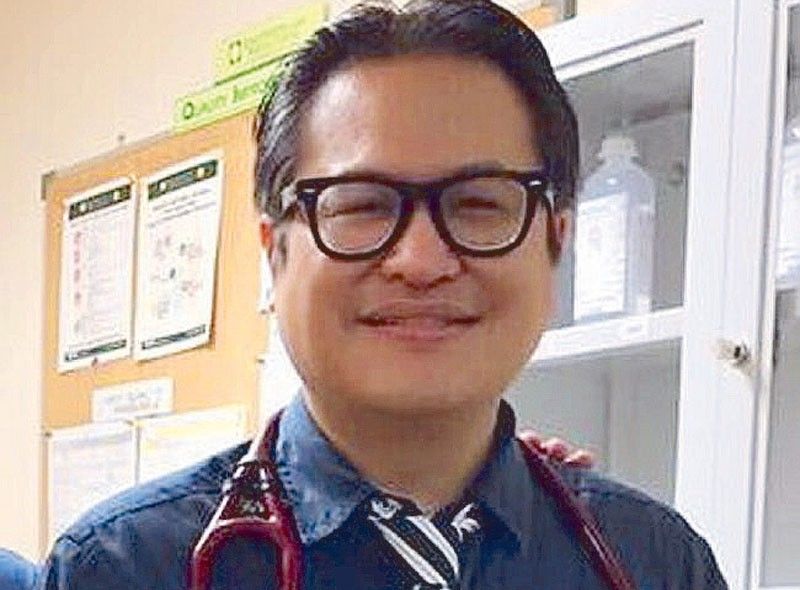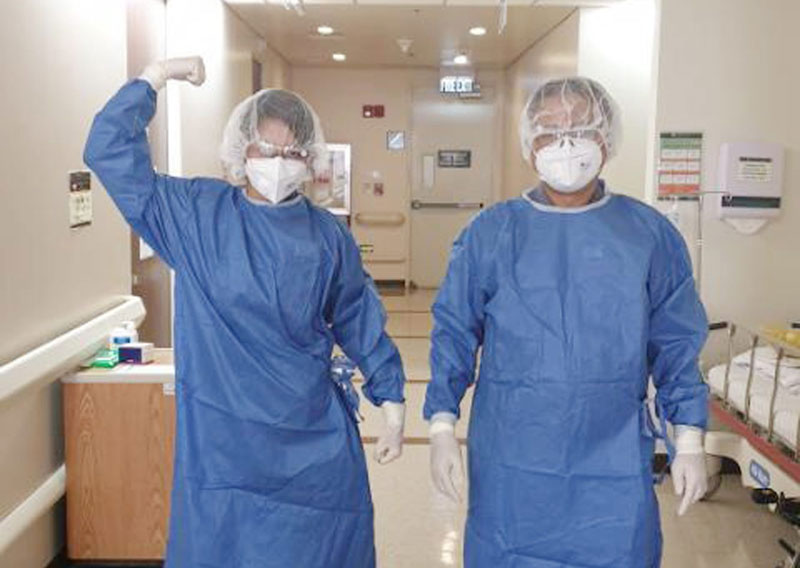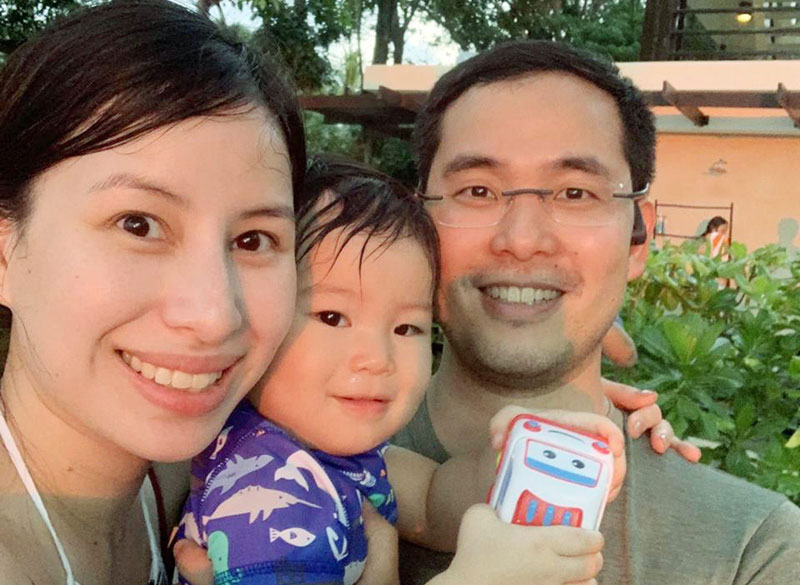Stories from COVID-19 frontliners


They’re fighting on the front lines of a war against a deadly enemy. Every day they risk their lives in the service of their fellow Filipinos, who cannot afford to take quarantine lightly. (Yes, we’re looking at you, Senator Koko Pimentel.) Meet three doctors who are all COVID-19 frontliners at major hospitals. These modern-day heroes epitomize profiles in courage.

Dr. Joseph Adrian L. Buensalido: ‘I almost cried as I hid behind my mask.’
What is a typical day in your life like now?
The worst was during the first wave. I am affiliated in four different tertiary hospitals. The first wave hit one of our hospitals hard because one of my colleagues (also an infectious diseases specialist) was exposed to a COVID-19 patient and needed to undergo home quarantine, while two other colleagues were essentially out because they were facing the crisis in another equally important institution. That left just two of us who handled the bulk of the COVID-19 and PUI cases. That meant coming to work at 7 a.m. and working continuously until 10 to 11:30 p.m.
I eat breakfast while driving on the way to work. When I arrive, I put on my mask and go to the COVID-19/PUI area. Before I enter, I wear my personal protective equipment (PPE), which includes booties, gown, mask, goggles or face shield, hair cover and then gloves. The gloves are changed after seeing each patient. We sanitize our hands each chance we get, even our gloved hands. Each movement during the day is measured because we do not want to contaminate any exposed areas in our body, especially our eyes, nose and mouth. Our phones are covered with plastic (or the waterproof case we use in the beach) so that we can still use it since there are many other calls regarding other patients, other hospital concerns, and even calls from family. Mind you, it is not easy to manipulate the phone with gloves on and with the plastic cover on.
We go and check the lab results of patients, their vital signs, interview them for a complete history (or for updates), and examine them, all the while taking care not to contaminate ourselves. Then we order what needs to be done, whether additional labs for monitoring or diagnostic purposes, and treatment. This goes on and on and on until you finish at least one floor, and you will be able to remove your PPE. Only when it’s removed can we use the bathroom and quickly eat, before we can move to another floor, where you have to gear up again and do the same things per floor, per area and per ICU.
After we see the last patient, you can get back to your car and drive home, still taking care to limit what you touch without first sanitizing your hands. Our ears will usually be sore and painful because the mask loop would have dug into our ears.
And it doesn’t end when you get home because when you do, you still need to enter “The Disinfection Unit,” an area that my wife made where I can remove all my clothes and stuff privately, and put on a clean white shirt and boxers. Only then can I knock so that the side door can be opened, give my wife and kids flying kisses, before heading straight to the shower to wash away any hint of contamination that my PPE may not have blocked. And once I am all clean, I would eat dinner, and they would sit with me since many times they would have eaten already. We talk for a bit, and then sleep to recharge for the next day.
That happened for more than a week and it was so grinding. At the end of the first wave, our colleagues came back and now we can do the same things but with a more balanced patient load.
What have been the scariest moments/situations for you?
There is actually no time to be scared. If you think about the risk to yourself, and by extension, to your family (because if you get infected with the virus, you might infect them, as well), you will just slow yourself down with anxiety and doubt. I try to maintain just a healthy dose of fear to fuel my resolve to make my actions sure and exact so as not to contaminate myself.
The most heartbreaking?
I see a lot of husband-and-wife patients. They need to be isolated in different rooms. They communicate by video call to see each other while they talk. Many times, one of them worsens and the other one remains stable before improving. Yesterday, I talked to one patient while the spouse was on video call. I had to deliver the bad news that the patient would probably need to be hooked to the ventilator because the patient’s lungs were failing. The patient asked about the status of the spouse and I said the latter was doing well and improving. He said he was happy for the spouse but I saw the patient’s scared look and the frightened face of the spouse on the phone. I almost cried as I hid behind my mask.
The most rewarding?
Discharging patients, whether COVID-19-confirmed or PUIs, who have improved from our treatment is the most rewarding, of course. But even small victories such as learning that the medicine you gave the night before brought about an improvement a patient’s chest X-ray, giving hope to a critically ill patient also makes me feel happy. Even the video conference meetings that we, the doctors with different specialties, do at night after a long day’s work to come up with improvements in the way that we can manage and help our patients, give me satisfaction.
Who are your most memorable patients and why did they make such an impression on you?
My most memorable patients are the elderly siblings (and one spouse) that I was able to discharge improved, except for one sibling. They were very obedient seniors and I was so happy because they got better and were ecstatic when they were finally given the go-signal to leave the hospital. Nonetheless, they were still ordered to undergo strict “home quarantine” even though they were discharged, as per DOH protocol.
What about your fellow doctors? Do you know any that have gotten infected or passed away?
Sadly, yes. I heard that nine out of the 38 deaths so far were doctors. Some of them were my teachers. We mourn them. We will never forget them. And we will never forget what they taught us. They are our fallen heroes, but the rest of us will carry the torch in their name. We will not give up until we win this war against COVID-19.
How do you keep your strength up physically, mentally and spiritually?
I eat fruits along with other types of food for breakfast and lunch. I eat a lot for dinner, including vegetables, because that’s when I can enjoy the food when I sit down at the table with my family. It’s not recommended to eat heavy at night, though. I don’t drink. I don’t smoke. I try to exercise at night when I am not too tired. I need to pray more, though.
Do you get a lot of help from outside, like for food and other necessities?
I have seen from social media that many establishments, before the lockdown, were giving free stuff, such as coffee, to healthcare workers. I didn’t have time to get one, though. I was too busy, and I bring my own coffee, food and water, anyway. I do get a lot of messages from private citizens asking how they can help. I appreciate those gestures very much. And I have seen that so may people have been donating PPEs to many different hospitals all around the Philippines. The spirit of bayanihan is still very much alive in the Philippines.
What is the state of the hospital’s manpower, supplies and medicines?
So far, I have not experienced dire shortage, but from time to time, we would have limited supplies. We have thought of ways to preserve our stock by changing our practices without sacrificing our welfare.
But I honestly cannot say it will continue to be this way. Without a steady supply of PPEs, we will surely run out, and a shortage will surely negatively affect the quality of care we can give.
In fact, I currently use my own supply of masks, which my wife stocked up for me before the pandemic accelerated. It is only before I enter the COVID-19/PUI areas when the hospital provides me and other workers N95 masks. But even my own stock will not last me for the next month.
Have measures so far like the lockdown been able to flatten the curve?
I think it has helped. I do hope everyone really does stay at home because it is through close contact that the virus will be able to spread. This is really one thing that we do not want to go “viral,” or else we will lose many individuals who have comorbid conditions, such as hypertension, diabetes, asthma and chronic obstructive pulmonary disease.
What can the general public do to help healthcare workers and hospitals the most?
Staying at home and avoiding crowds is essential. Follow the government’s directives and doctors’ orders. Wash your hands before touching your nose, mouth and eyes. Keep yourselves healthy so that less and less will need to go to the hospital. Ask your local physicians, nurses, healthcare workers and hospitals how you can help without violating the enhanced community quarantine.
And lastly, we need prayers. After all, He is the greatest healer.

Dr. Gian Paulo V. Flores: ‘Every day is a scary moment for me.’
What are the kidney complications associated with COVID-19?
Infections like that cause kidney injury, which is usually common in the elderly or people with pre-existing medical conditions like heart failure, diabetes or cancer. COVID decreases the blood flow to the kidney because the blood goes to essential organs like the heart or brain, so kidney functioning is compromised.
What was the scariest moment for you?
Every day is a scary moment for me because the fact that you are already in the hospital predisposes you already for infection. There are so many cases now, particularly ICU patients, it’s risky in terms of exposure, because most of them are on ventilators and we know that with a ventilator, a BiPap or high-pressure oxygen mask, the capacity of the virus to transmit is much more efficient.
What was your most heartbreaking moment?
The first doctor who recently died because of COVID, Dr. Israel Bactol, was my senior. I graduated from Pamantasan Ng Lunsod Ng Maynila, and that particular doctor was one of my seniors in medical school. He was a cardiologist fellow at the Philippine Heart Center. That was heartbreaking because he was already a third-year cardiologist, and because training is only three years, he was already graduating. He was just doing his job and then it cost his life because of service. But that’s our job.
Right now what is the state of the hospital’s manpower, supplies and medicine?
Manpower is still manageable. The workforce is not so depleted, but the supply of personal protective equipment is dwindling, so the departments are asking for donations to replenish personal protective equipment.
Have government measures like the lockdown been able to flatten the curve?
It’s not apparent yet, flattening the curve, but in terms of discipline and decreasing incidence of COVID, I think the lockdown helps. Of course there are stubborn people out there, like the ones in the wet market who aren’t social distancing.
What can the general public do to help healthcare workers and hospitals the most?
Basically by staying at home and not becoming part of the problem. That’s really it, because if they are not adhering to government healthcare policies, they will just add to the disease burden.
And also moral support. Healthcare workers get tired and simple encouragement — posts — we appreciate that so much. It boosts morale.
* * *

Dr. Daniel Luchangco:‘It’s fighting a losing battle.’
What is a typical day in your life like?
I go on duty every day, over an eight-hour shift. Lately we’re seeing more patients and they’re sicker than before. Prior to March 10 or 11, we had designated some areas where we would put the people infected with COVID, and that’s where we would wear the protective equipment. But around March 10 or 11, we just gave up and said the entire ER is a COVID zone.
Have government measures like the lockdown been able to flatten the curve?
The healthcare workers and community cases we’re getting now were affected last week before the quarantine. If the quarantine worked, next week we should have a flatter curve. If not, we’ll be in a lot of trouble, because all the major hospitals are already full. If we still get an influx next week, we don’t know where we’re going to put them anymore. Right now I have something like 30 patients waiting to get a room.

What do you think about the Koko Pimentel incident?
It’s one incident but we have to look at it as an indication — like a microcosm — of what’s probably happening out there. People shouldn’t be visiting and going to parties. And he’s not the only one at the party, so these people didn’t consider that to be a dangerous activity when it was clearly stated. We all know we should be social distancing, that’s why I’m not so optimistic about this quarantine so far. I’m not so sure it will be able to really flatten the curve to a significant degree.
Thus far, have you had to make the godlike triage decisions they’ve had to make in countries like Italy?
Speaking for MMC, we’ve had the equipment and the supplies so far. It’s abnormal to have a 30-person wait line for rooms, but I would say that at least they’re all getting care at the moment.
How do you keep your strength up physically, mentally and spiritually?
It’s draining. For one, just pulling extra shifts is physically draining; to work in full protective gear is also quite tiring. And I also coordinate for other hospitals in their response, coordinating donations for equipment and systems like that. So it’s not even a full rest when you’re out. Things are just needed to survive, so when I’m not on duty, I’m trying to work on things that will help make conditions better in the hospital. It’s fighting a losing battle, the hospital front, because we’re just trying to shore things up, and tread water. I’m an ER doctor so in normal times, you get to save lives, make a drastic or significant difference in the outcome. But with this, the frustrating part is sometimes we get patients who are already on a continuum we can’t alter, and we just end up losing. So that gets tiring. But also we have to keep our strength up as well, because our immune systems have to be better than usual. It’s not a good time to get sick.
Do you witness a lot of heroic acts or behavior on a daily basis?
If you look at social media, a lot people think “heroics,” but really we’re just trying to keep our heads above water. I wouldn’t say we’ve changed anything. We’re on a track of admitting patients with the virus, but if I were to keep score, I would say that we’re not winning.
Yes, that’s what you wrote about in your Facebook post. So what can the general public do to help?
A lot of businesses closed down because of quarantine, but actually what would be better is to establish an actual quarantine facility, for people to be there 14 days voluntarily — that would take the government to get involved.
One idea is there are a lot of hotels now unused, they could have one room per patient, so they’re quarantined, then they can be released — this is an idea that’s worked in other countries for severe quarantine cases. In other cases, many will recover outside on their own. Some of them will require hospitalization. So in theory, we could stop the transmission and spreading.
For example, repurpose a hotel as a quarantine facility, then somebody has to feed the people, do their laundry. It takes a lot of organization to do that. Even things like accounting, someone has to account for everything and manage the finances and there’s lots of cash donations pouring in, even a lot of food coming into the hospital. But we just have to remember that we’re supporting a losing battle at the hospital. Some of that food could be channeled to quarantine facilities, so that people would still be fed, taken care of — that might make a dent.
Setting up a quarantine facility through a private initiative will take time. So even if people started doing it now, it would be a couple of weeks before we could get that together, all the guidelines and the logistics of coordinating, availability of systems. I’ve seen lots of people with different solutions — people with a catering services saying, “I can deliver food,” or buses that can shuttle people around— these are all parts that need to be put together. All the resources are out there; it would take coordinated effort to make it all come together.
Unfortunately, you can’t ask some hospitals to run a quarantine facility. They’ll say, “We can’t even run our own hospitals right now!” Somebody else has to do it.
* * *
Follow the author on Facebook or Instagram @theresejamoragarceau.















